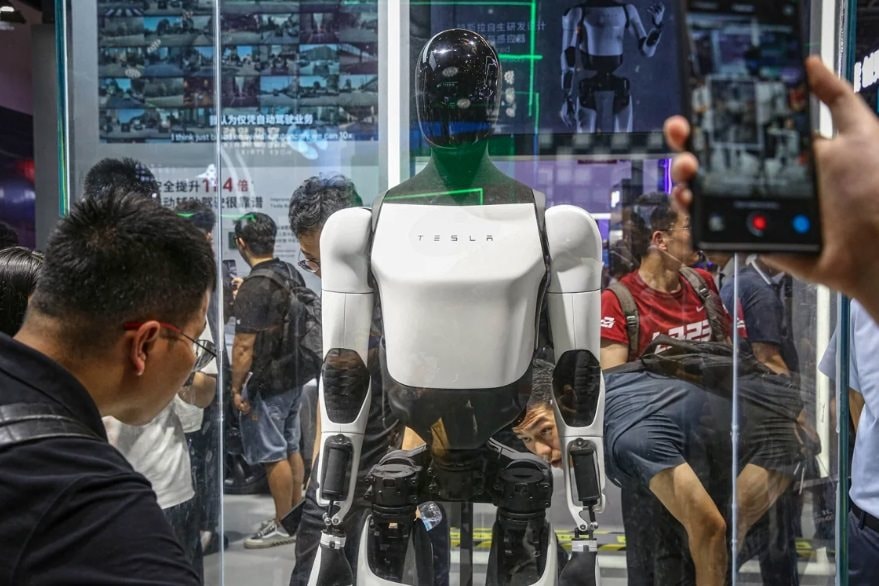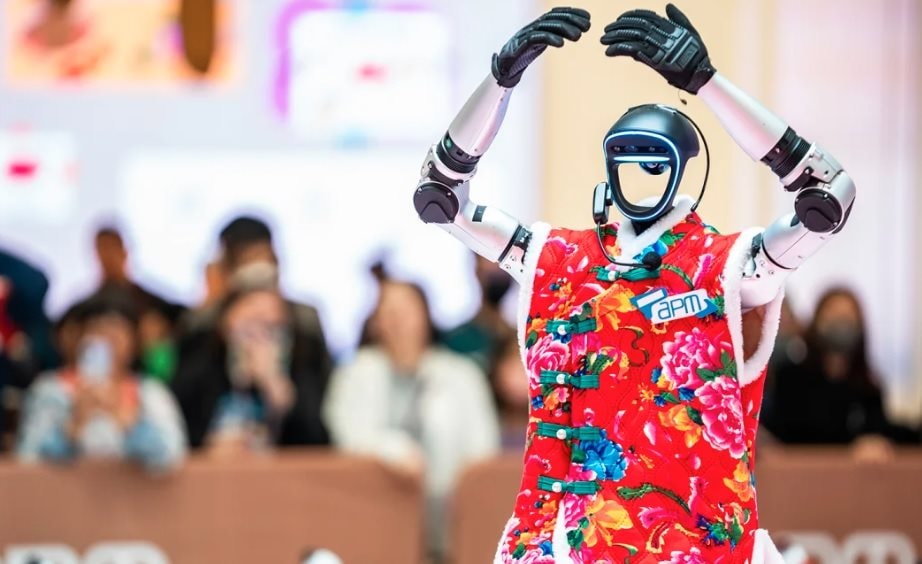China is in a fierce race with Elon Musk in an extremely hot field.
![]()
Waving bright red handkerchiefs and dancing to folk music, more than a dozen humanoid robots took to the stage in China’s biggest city in January, making a splash during a televised Lunar New Year celebration.
The spectacular performance – which attracted more than a billion viewers – was a testament to the remarkable progress made by China’s humanoid robotics industry. Over the past two months, videos of Chinese robots performing impressive feats such as cycling, roundhouse kicks and somersaults have gone viral on the internet, amplified by state media as a symbol of their potential to boost economic growth.
While only a handful of humanoid robots are currently in mass production, the race to take on Elon Musk’s Tesla – one of the pioneers in the field – is heating up. The vision of an “I, Robot” future, where machines take over housework or become caregivers, is attracting major investments in humanoid robots and autonomous technology from both the US and China.
Microsoft, Nvidia and Amazon founder Jeff Bezos have all invested in Figure AI, a US company that makes humanoid robots. Meanwhile, Meta is also planning to make major investments in the field, according to a Bloomberg report last month.
Elon Musk, who launched the humanoid robot Optimus in 2022 and quickly attracted global attention, recently predicted that the project alone could generate more than $10 trillion in revenue.
While it may take another five to 10 years before humanoid robots make a real impact on society, in the long run they could become the next mainstream consumer electronics, according to Xi Ning, professor and chair of robotics and automation at the University of Hong Kong.
“Everyone will eventually need them — just like cars, just like mobile phones — and the potential market size is huge,” he told CNN.
Goldman Sachs predicted last year that the global humanoid robot market would be worth $38 billion by 2035. Over the next five years, it estimates that about 250,000 humanoid robots — mostly for industrial use — will be shipped. Meanwhile, consumers are expected to buy about a million units a year over the next decade.
Beijing, eager to replicate China’s success in electric vehicles (EVs), is looking to take the lead in this new wave of growth.
The Chinese government is aggressively positioning the country as a global tech powerhouse, while also capitalizing on the momentum of recent breakthroughs – such as DeepSeek’s AI reasoning model that stunned the world in January – especially as the US tightens its tech restrictions on Beijing.
Despite entering the race later than US rivals such as Tesla, Boston Dynamics and Figure AI, Chinese companies are quickly closing the gap, experts say. With their “supernatural” ability to optimize supply chains and cut costs, Chinese companies are also accelerating the mass production of humanoid robots.
CATCHING UP
China has already dominated the industrial robot market. According to the Germany-based International Federation of Robotics, as of 2021, China has deployed more industrial robots than the rest of the world combined.
Compared to humanoid robots, industrial robots typically use less sophisticated technology and perform simpler tasks – mostly used in production lines or transportation at factories.
Similar to the electric vehicle sector, Tesla was one of the few prominent names pioneering the humanoid robot race when Elon Musk announced the project in 2021 and launched the Optimus prototype a year later. Since then, the Chinese government has publicly shown strong support for the humanoid robot industry with large funding programs and supportive policies from the state.
In a policy document issued in 2023, China’s Ministry of Industry and Information Technology identified the humanoid robot industry as a “new technological frontier” in global competition, and set a goal of achieving mass production capacity and ensuring a stable supply chain for core components by 2025.
“China started a little later, but it has its own advantages such as a huge domestic market and a relatively complete technology supply chain, which allows it to develop similar robots at a lower cost,” said Professor Xi Ning.
Over the past three years, several local governments — including major cities like Beijing, Shanghai and Shenzhen — have announced plans to set up or launch dedicated investment funds for robotics, totaling at least 73 billion yuan ($10 billion), according to a CNN count.
Last month, Chinese President Xi Jinping hosted a high-level meeting with the country’s top business leaders. In the front row was Wang Xingxing, CEO of Unitree, the company behind a series of dancing robots that went viral — a clear sign that Beijing is placing increasing emphasis on the emerging technology sector.
In addition to Unitree, other prominent domestic companies include Shenzhen-based UBTech; Agibot, backed by electric vehicle giant BYD; Robotera in Beijing; Fourier Intelligence in Shanghai; and electric vehicle maker XPeng has also entered the game.
LACK OF TECHNOLOGY
Despite dominating the global supply chain, experts say China is still lagging behind the West in some key technologies. About 56% of companies in the humanoid robot supply chain are based in China, according to a Morgan Stanley research report released last month.
However, China still needs to make breakthroughs in “core technologies” such as processing chips, high-precision sensors and operating systems for robots to reduce its dependence on foreign technology, according to Professor Zhang Dan, Dean of the Department of Intelligent Robotics and Automation at the Hong Kong Polytechnic University.

Artificial intelligence (AI) chips are the foundation for operating humanoid robots, helping to control their thinking, perception and movement. Currently, many robot developers are still relying on products from Nvidia – the US AI chip giant. At its annual conference for developers last week, Nvidia announced a new platform AI model specifically for humanoid robots.
Under President Joe Biden, the US government has continuously tightened regulations on exporting advanced chips due to national security concerns. In response, Beijing has stepped up the development of a domestic chip supply chain as part of its technology self-sufficiency strategy.
In addition, companies from Europe, the US and Japan still dominate the market for high-end components – from sensors to motors and precision screws – which play a key role in helping robots operate stably and sophisticatedly.
To overcome this weakness, many Chinese suppliers are proactively approaching Tesla. Many Chinese companies have sent component samples to Tesla for testing, according to P.K. Tseng, senior research director at market analysis firm TrendForce.
“After supplying components to Tesla, Chinese manufacturers will improve their products based on test feedback, and then provide upgraded versions to domestic manufacturers,” he explained.
Over time, this process creates a continuous loop of technological development, thereby improving the overall quality of China’s humanoid robot industry.
THE PRICE DESTROYER
Despite the technology gap, China has emerged as a “cost disruptor” in this nascent industry.
Engine AI, a Shenzhen-based company, launched the PM01 late last year for just 88,000 yuan ($12,175). Meanwhile, Unitree’s G1 model – which can perform a roundhouse kick – sells for 99,000 yuan (about $13,697).
At an event last year, Elon Musk estimated that Tesla’s Optimus humanoid robot would cost between $20,000 and $30,000. Reducing the price of humanoid robots is seen as an important step towards commercialization and widespread adoption.

Not only startups, but also big players in the electric vehicle industry such as BYD and XPeng have begun to enter the field of humanoid robots. According to experts, years of fierce competition and price wars in the Chinese market have helped these companies hone their ability to rapidly expand production and optimize costs effectively.
Because the production process of humanoid robots has many similarities with that of electric vehicles – especially in components such as sensors and batteries – EV manufacturers clearly have a competitive advantage when entering this market, said Brady Helwig, director of economics at the Special Competitive Studies Project.
Late last year, XPeng launched a humanoid robot called Iron, and announced plans to mass produce it by the end of 2025. Around the same time, BYD also started a recruitment campaign to develop its own version of the robot, after investing in several domestic humanoid robot manufacturers.
As China’s population crisis worsens, its leaders see humanoid robots as a potential solution to make up for its shrinking workforce. In fact, China’s population has been falling for three years in a row.
“If humanoid robots can be mass produced and deployed in the economy, it could be the surprise factor that could really close the labor gap,” says expert Brady Helwig.
News
Sex And The City star secretly married for the fourth time to a boyfriend 15 years younger
Accordingly, this is the fourth marriage of the Sex And The City star. According to international media such as People…
Jennifer Lopez removes Ben Affleck’s name tattoo after divorce
Singer Jennifer Lopez covered up the word ‘Ben’ with a hummingbird tattoo after finalizing her divorce earlier this year. J.Lo…
Rory McIlroy, Scottie Scheffler, Tommy Fleetwood, Ben Griffin nominated for PGA Tour’s 2025 Player of the Year award
The PGA Tour has announced Scottie Scheffler, Rory McIlroy, Ben Griffin and Tommy Fleetwood on its shortlist for Player of…
Elon Musk’s X fined 120 million euros by EU
Elon Musk’s X fined €120m by EU in first clash under new digital laws Ruling likely to put European Commission…
It’s official: Michael Bublé is going country.
Michael Bublé Reveals Major Career Shift With Surprise Country Album: All the Details The Voice star spilled on Kylie Kelce’s podcast that…
Post Malone is honored as a headlining artist at the Super Bowl concert.
Country Music Superstar Named Super Bowl Concert Headliner You’ve certainly heard that not everyone is on board with Bad Bunny…
End of content
No more pages to load












